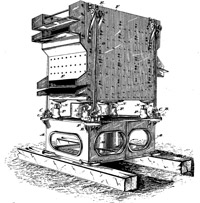
News & announcements
Saving your history
Early accounts
Maps
Nearby towns
People
Churches
Schools
Municipal
Organizations
Businesses
The mines
Transportation
Streets
Buildings
Entertainment
Celebrations
Sports
Ethnic groups
Salmon Iron Works
What's on this page:
- Salmon patents
- Map details (see especially the railroad tracks in 1923
view)
- Salmon Iron Works in the news 1899-1933
- Later businesses operating at the Salmon foundry site
- Listings on Sanborn Fire Insurance maps and in the 1901 directory
- Factories and
other industries - new page begun, to be expanded soon
- Freelanders with patents
The image at top left comes from the digital copy of an 1899 Eckley B. Coxe and Samuel Salmon patent for a screening mechanism for coal processing. Thanks to Google for making these patents available.
If the Samuel Salmon listed at the Findagrave website was the creator of the Salmon Iron Works, he was born in 1836, son of Levi and Mary Salmon, died in 1916 at age 80, and is buried in the Freeland Cemetery. According to the obituary, “He was head draftsman for Coxe Bros. for many years and an expert in his line of work.”
Salmon patents
In 1888-1890 Samuel Salmon of Drifton was awarded five patents for inventions connected with coal processing. Four of them were submitted under Eckley B. Coxe and S. Salmon, and a fifth under Ezra B. Ely & Samuel Salmon. Salmon would later bring the idea of creating a foundry to manufacture some or all of these to Freeland’s Board or Trade. The Salmon foundry was short-lived, but additional businesses used the site for nearly a century. Thanks to Ed Merrick for the information about these patents.
Eckley B. Coxe & S. Salmon, of Drifton, Pa. – Automatic Slate Picker – Patented May 1, 1888
https://patents.google.com/patent/US382215
Eckley B. Coxe & S. Salmon, of Drifton, Pa. – Screening Mechanism – Patented May 28, 1889
https://patents.google.com/patent/US403989
Eckley B. Coxe & S. Salmon, of Drifton, Pa. – Screening Mechanism – Patented May 28, 1889
https://patents.google.com/patent/US403990
Eckley B. Coxe & S. Salmon, of Drifton, Pa. – Mechanism for Screening Coal – Patented Jan. 7, 1890
https://patents.google.com/patent/US419113A/en
Ezra B. Ely, of Bergen Point, N. J. & Samuel Salmon, of Drifton, Pa. – Mechanism for Loading Coal – Patented Jan. 7, 1890
https://patents.google.com/patent/US419145
Sanborn Fire Insurance map details (thank you to the Library of Congress and to Penn State for making their digital map collection accessible online) showing the southeast quadrant at the intersection of Birkbeck and Johnson streets:
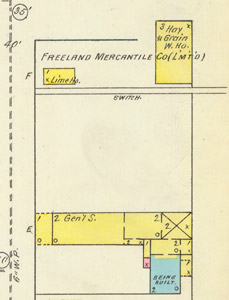 On the
1895 map the feed mill that would be the B. F. Davis feed mill is
labeled “Freeland Mercantile Co. (Lmtd)” and the foundry didn’t exist.
There was a general store where Berger’s would later be.
On the
1895 map the feed mill that would be the B. F. Davis feed mill is
labeled “Freeland Mercantile Co. (Lmtd)” and the foundry didn’t exist.
There was a general store where Berger’s would later be.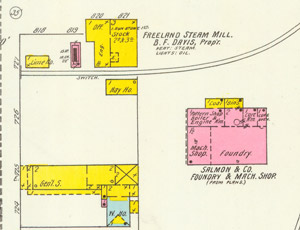 In 1900 the
feed mill is now listed as the Freeland Steam Mill, B. F. Davis,
Prop’r, and the Salmon foundry and machine shop is shown “from plans”,
which suggests it was still being built at the time the map survey team
was in Freeland.
In 1900 the
feed mill is now listed as the Freeland Steam Mill, B. F. Davis,
Prop’r, and the Salmon foundry and machine shop is shown “from plans”,
which suggests it was still being built at the time the map survey team
was in Freeland. 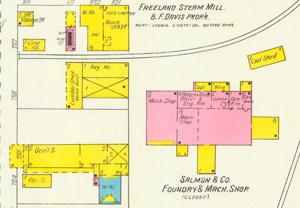 The 1905
drawing shows that the foundry and machine shop has been expanded, but
is labeled “Closed”. Note railroad tracks on both sides for this and at
least one other business.
The 1905
drawing shows that the foundry and machine shop has been expanded, but
is labeled “Closed”. Note railroad tracks on both sides for this and at
least one other business.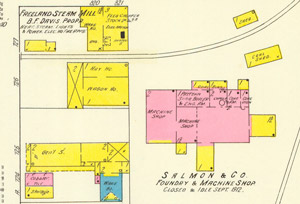 The 1912
drawing of the foundry and machine shop is the same, now labeled
“Closed & idle Sept. 1912”.
The 1912
drawing of the foundry and machine shop is the same, now labeled
“Closed & idle Sept. 1912”.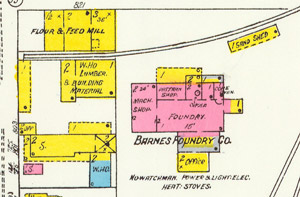 In 1923 this
business was labeled “Barnes Foundry Co.” and the building has been
modified slightly.
In 1923 this
business was labeled “Barnes Foundry Co.” and the building has been
modified slightly.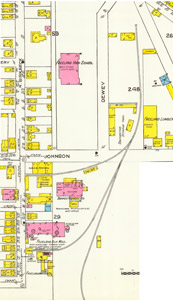 This larger view of the area from the 1923 map shows the
railroad spurs that extended from the main line to the Freeland
Electric Light, Heat and Power Co. and the Freeland Water Co.,
and another from the main line to the feed mill, listed on the 1895 map
as the Freeland Mercantile Co. The main line
continued northward for another block or so, in 1923 servicing the
Freeland Lumber Company and ending just past an ice house. The Salmon
foundry (which was by 1923 the Barnes foundry) was situated to take
advantage of this railroad access. The spurs were in place at least as
early as 1895, servicing the power company and silk mill and also the
feed mill.
This larger view of the area from the 1923 map shows the
railroad spurs that extended from the main line to the Freeland
Electric Light, Heat and Power Co. and the Freeland Water Co.,
and another from the main line to the feed mill, listed on the 1895 map
as the Freeland Mercantile Co. The main line
continued northward for another block or so, in 1923 servicing the
Freeland Lumber Company and ending just past an ice house. The Salmon
foundry (which was by 1923 the Barnes foundry) was situated to take
advantage of this railroad access. The spurs were in place at least as
early as 1895, servicing the power company and silk mill and also the
feed mill.Charlie Gallagher pointed me to the map view and explained these tracks: The one spur goes north behind the Freeland Pattern Works. It was mostly there when I was young. It had to be long enough so that a locomotive and one or two cars could extend past the switch to the Davis Feed Mill. Remember, you had to take the train past the switch, go forward to pick up the empty car at the Feed Mill, back out, set the empty past the switch, unhook, go back through the switch, the back the new loaded car into the feed mill. They also brought railroad tank cars to Herbener’s Fuel Service.
The stone backstop at the end of the spur that serviced the feed mill and the foundry is still in place, across the street from what used to be Krone’s. There are still faint traces of these tracks here and there, even now. Many thanks to Charlie Gallagher for pointing them out.
Salmon Iron Works in the news
Ed Merrick did the research to find these articles from newspapers of the day. They are summarized here, and a few are included in their entirety.
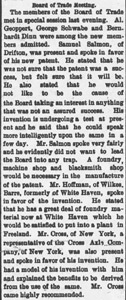 January 26, 1899:
January 26, 1899:
At a Board of Trade meeting Samuel Salmon of Drifton spoke about his new patent, which was currently undergoing testing. He noted that a foundry, machine shop and blacksmith shop would be necessary for the manufacture of the patent. Mr. Hoffman, formerly of White Haven, offered foundry material he still had in White Haven to contribute to a plant in Freeland.
April 25, 1900:
“Attorney G. T. Brown left for Philadelphia yesterday to purchase the requisite material necessary in the contruction of the Salmon Iron Works, now in course of erection.”
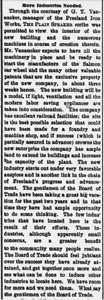 July 28, 1900:
July 28, 1900: G. T. Vanaucker, manager of the Freeland Iron Works, gave the reporter a tour of the new plant building, and the various machines being built. He said he expected the company to begin operation in about 3 weeks. The new building will be a model of light, ventilation and modern labor saving appliances, and with excellent railroad facilities. The location is good and will allow for expansion as needed. The reporter ended the article by exhorting the Board of Trade to bring more industry to Freeland.
December 20, 1900:
“August Hoffman has resigned his position as manager of the foundry in the Salmon Iron Works. He will be succeeded by Charles Ginter.”
May 16, 1901:
“The employees of the Salmon Iron Works have petitioned their employers for a half holiday on Saturdays.”
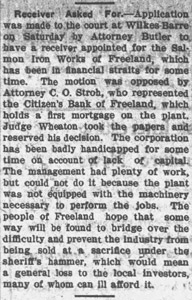 September 19, 1904:
September 19, 1904: Receiver Asked For
“Application was made to the court at Wilkes-Barre on Saturday by Attorney Butler to have a receiver appointed for the Salmon Iron Works of Freeland, which has been in financial straits for some time. …”
October 18, 1904:
Iron Works Employees Paid
“The wage claims of the employees of the Salmon Iron Works were paid in full last evening by the Citizens Bank of Freeland. The men assembled in Squire Buckley’s office and satisfied the docket, after which they received checks for the amount due. The employees feel grateful to the officials of the bank for their promptness in paying off the wage claims after securing control of the property.”
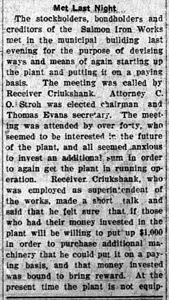
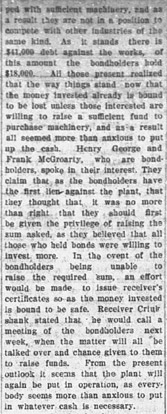 March 14, 1906:
March 14, 1906: Met Last Night
“The stockholders, bondholders and cerditors of the Salmon Iron Works met in the municipal building last evening for the purpose of devising ways and means of again starting up the plant and putting it on a paying basis. … The meeting was attended by over forty, who seemed to be interested in the future of the plant, and all seemed anxious to invest an additional sum in order to again get the plant in running operation …”
March 16, 1906:
Meeting Called
“Receiver Cruikshank has called for a meeting of the bondholders of the Salmon Iron Works on next Thursday evening. It is thought that the bondholders will subscribe a sufficient sum of money to again put the plant into operation.”
September 18, 1906:
Iron Works To Resume
“Announcement was made that the Salmon Iron Works, which have been closed for a year on account of going into the hands of a receiver, would shortly resume operations.”
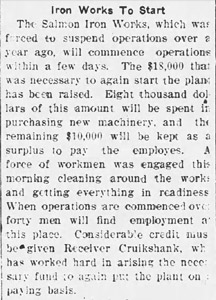 November 20, 1906:
November 20, 1906:Iron Works To Start
“… The $18,000 that was necessary to again start the plant has been raised.”
December 28, 1906:
A Bright Future
“The Salmon Iron Works, which recently resumed operations after a suspension of several months, are daily increasing their force, and those who are interested in it entertain a bright future for it. The work of installing additional machinery will be commenced next week, and then it is believed that the plant will be made a paying proposition. General Manager Cruikshank, who has labored hard in an effort to again get it into operation, is of the opinion that it will in a short time be one of Freeland’s leading industries.”
September 11, 1909:
“Several prominent Hazletonians were in the city to-day in regard to the Salmon Iron Works of Freeland which is to be disposed of at sheriff’s sale.”
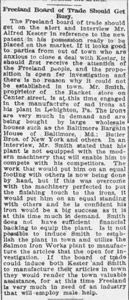 July 27, 1910:
July 27, 1910: Freeland Board of Trade Should Get Busy
“The Freeland board of trade should get on the alert and interview Mr. Alfred Kester in reference to the new patent in his possession ready to be placed on the market. …”
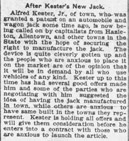 July 27, 1910:
July 27, 1910: After Kester’s New Jack
“Alfred Kester, Jr., of town, who was granted a patent on an automobile and wagon jack some time ago, is now being called on by capitalists from Hazleton, Allentown, and other towns in the State with the hope of securing the right to manufacture the jack. …”
March 1, 1911:
Took Inventory
“Richard Rober, of Detroit, arrived in town to consult with William Ashman in reference to the manufacturing of the Reversable motor invented by Geo. Ashmna, who is now at Detroit, where the device is being perfected. From all reports the motor is a big success and will soon be placed on the market. The above named gentlemen met the following directors of the Citizens’ Bank: President H. C. Koons, of Bethlehem; B. R. Davis, cashier of Hazleton, and Geo. Kugler of town, and made an inventory of the Salmon Iron works, which is owned by the bank, for the purpose of leasing the plant to manufacture the motor and several other mechanical devices. The plant was thoroughly gone over and it is more than likely a satisfactory agreement will be reached by the parties concerned.”
June 6, 1911:
“The Citizens’ Bank appealed to the council to assist them in protecting the Salmon Iron Works from destruction at the hands of vandals. The matter was referred to the police committee.”
[At some point, a new foundry was opened in this building, the Barnes Foundry, mentioned in this 1922 article and on the 1923 Sanborn Fire Insurance map. - CT]
November 23, 1922:
Moved To Birkbeck Street
"Supt. A. A. White, of the Barnes foundry on Johnson street, who was residing temporarily with his parents on Adam street, is now located in the Howard Zeisloft home on Birkbeck street."
January 24, 1924:
Destroying Local Property
"Borough Engineer Reichman, on making a tour of the town discovered that some mischievous boys who are in possession of flobert rifles, have cultivated the practice of smashing the windows in the abandoned foundry on Johnson street. The matter was reported to the local police officers with instructions to round up the boys so that they can be arraigned before the Burgess in order to collect the amount of damages incurred and to abate the uncalled for practice if possible."
November 2, 1926:
“Workmen are dismantling the Salmon Iron Works in Freeland. The machinery was purchased by the Hazleton Machinery and Supply Company.”
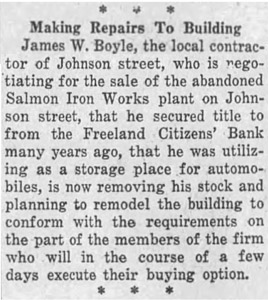 September 20, 1930:
September 20, 1930: Making Repairs To Building
James W. Boyle, local contractor, is negotiating for the sale of the abandoned Salmon Iron Works plant on Johnson street, that he secured title to from the Freeland Citizens’ Bank many years ago and that he was utilizing as a storage place for automobiles …
December 2, 1933:
“Morris McClellan this afternoon bought the Salmon Iron Works of Freeland for $6,300, about one-eleventh of their value, at the receiver’s sale.”
Other businesses operating at the Salmon foundry site
[Thanks to Charlie Gallagher and Carol Jones for their memories of some of these businesses.]
Freeland Foundry and Machine Co. - In his book Freeland, Charlie Stumpf wrote: “The Freeland Foundry and Machine Co. was organized on February 4, 1918. The business opened in the former Salmon Iron Co. building on Johnson Street. The new firm manufactured ship propeller wheels and other ship parts.” (p. 31)
Barnes Foundry Co. - The 1923 map detail above shows the foundry under new ownership as the Barnes Foundry Co.
Car storage, James W. Boyle - The 1930 newspaper clipping cited in the previous section says that James W. Boyle, contractor and auto salesman, had secured the title to the building from the Citizens Bank to store automobiles.
The 1933 newspaper clipping cited in the previous section says that Morris McClellan bought the Salmon Iron Works at the receiver’s sale.
Bus garage - Charlie Gallagher recalls that for some period of time (before Ed Husovich opened a factory there) the building was used as a bus garage, perhaps by the Stanley Garage for the Luzerne & Carbon buses they ran. The Stanley Garage was located across the street.
Sewing factory, Ed Husovich - Both Carol Jones and Charlie Gallagher remember Ed Husovich having a sewing factory in the old Salmon building, sometime around the 1960s-1970s.
Herbener's - Charlie remembers that Ed Husovich later bought Herbener’s / Frame Lehigh and was the last owner of Herbener’s Service Station, having bought it after the retirement of Julius A. “Butch” Herbener in 1988. The station had been begun by his father Julius Herbener, and Butch joined him there after graduating from MMI in 1953, according to his obituary. There was an office for Frame Lehigh attached to the service station for a while (Frame Lehigh had purchased Herbener Fuel Service around the time of the passing of Julius Herbener in 1979).
Dei Tos Ornamental Concrete - Also according to Charlie, Dei Tos Ornamental Concrete (Nick Deitos, proprietor) was the last occupant of this site; he remembers the cement bins being there.
Listings on Sanborn Fire Insurance maps and in the 1901 directory
1900 Sanborn Fire Insurance map:
Salmon & Co. Machine Shop (on map index)
Salmon & Co. Foundry & Mach. Shop ("From Plans")
1900-1901 Pruden's Wilkes-Barre - Scranton Business Directory:
Salmon's Axle Works
1905 Sanborn Fire Insurance map:
Salmon & Co. Machine Shop
Salmon & Co. Foundry & Mach. Shop ("Closed")
1912 Sanborn Fire Insurance map:
Salmon & Co. Foundry & Machine Shop
Salmon & Co. Foundry & Mach. Shop ("Closed & Idle, Sept. 1912")
1923 Sanborn Fire Insurance map:
Barnes Foundry Co.
Thank you to Ed Merrick, Charlie Gallagher and Carol Jones for contributions to this page.